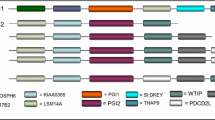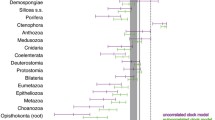Abstract
Previously we suggested that four proteins including aldolase and triose phosphate isomerase (TPI) evolved with approximately constant rates over long periods covering the whole animal phyla. The constant rates of aldolase and TPI evolution were reexamined based on three different models for estimating evolutionary distances. It was shown that the evolutionary rates remain essentially unchanged in comparisons not only between different classes of vertebrates but also between vertebrates and arthropods and even between animals and plants, irrespective of the models used. Thus these enzymes might be useful molecular clocks for inferring divergence times of animal phyla. To know the divergence time of Parazoa and Eumetazoa and that of Cephalochordata and Vertebrata, the aldolase cDNAs from Ephydatia fluviatilis, a freshwater sponge, and the TPI cDNAs from Ephydatia fluviatilis and Branchiostoma belcheri, an amphioxus, have been cloned and se-quenced. Comparisons of the deduced amino acid sequences of aldolase and TPI from the freshwater sponge with known sequences revealed that the Parazoa-Eumetazoa split occurred about 940 million years ago (Ma) as determined by the average of two proteins and three models. Similarly, the aldolase and TPI clocks suggest that vertebrates and amphioxus last shared a common ancestor around 700 Ma and they possibly diverged shortly after the divergence of deuterostomes and protostomes.
Similar content being viewed by others
References
Adachi J, Hasegawa M (1992) Computer science monographs, No. 27, MOLPHY: programs for molecular phylogenetics, I. PROTML: maximum likelihood inference of protein phylogeny. The Institute of Statistical Mathematics, Tokyo
Adachi J, Cao Y, Hasegawa M (1993) Tempo and mode of mitochon- drial DNA evolution in vertebrates at the amino acid sequence level: rapid evolution in warm-blooded vertebrates. J Mol Evol 36: 270–281
Alber T, Banner DW, Bloomer AC, Petsko GA, Phillios D, Rivers PS, Wilson IA (1991) On the three-dimensional structure and catalytic mechanism of triose phosphate isomerase. Philos Trans R Soc Lond Biol 293: 153–171
Berger MP, Munson PJ (1991) A novel randomized iterative strategy for aligning multiple protein sequences. Comput Appl Biosci 7: 479–484
Britten RJ (1986) Rates of DNA sequence evolution differ between taxonomic groups. Science 231: 1393–1398
Conway Morris S (1993) The fossil record and the early evolution of the Metazoa. Nature 361: 219–225
Davidson EH, Peterson KJ, Cameron RA (1995) Origin of bilaterian body plans: evolution of developmental regulatory mechanisms. Science 270: 1319–1325
Dayhoff MO (1978) Survey of new data and computer methods of analysis. In: Dayhoff MO (ed) Atlas of protein sequence and structure, vol 5, suppl 3. National Biochemical Research Foundation, Washington, DC, pp 1–8
Dickerson RE (1971) The structures of cytochrome c and the rates of molecular evolution. J Mol Evol 1: 26–45
Dickerson RE, Geis I (1983) Hemoglobin. Benjamin/Cummings, Menlo Park, CA
Doolittle RF, Feng DF, Tsang S, Cho G, Little E (1996) Determining divergence times of the major kingdoms of living organisms with a protein clock. Science 271: 470–477
Felsenstein J (1985) Confidence limits on phylogenies: an approach using the bootstrap. Evolution 39: 783–791
Frohman MA, Dush MK, Martin GR (1988) Rapid production of full- length cDNAs from rare transcripts: amplification using a single gene-specific oligonucleotide primer. Proc Natl Acad Sci USA 85: 8998–9002
Gamblin SJ, Davies GJ, Grimes JM, Jackson RM, Littlechild JA, Watson HC (1991) Activity and specificity of human aldolases. J Mol Biol 219: 573–576
Grishin NV (1995) Estimation of the number of amino acid substitutions per site when the substitution rate varies among sites. J Mol Evol 41: 675–679
Hasegawa M, Kishino H, Yano T (1987) Man’s place in Hominoidea as inferred from molecular clocks of DNA. J Mol Evol 26: 132–147
Hashimoto T, Nakamura Y, Nakamura F, Shirakura T, Adachi J, Goto N, Okamoto K, Hasegawa M (1994) Protein phylogeny gives a robust estimation for early divergences of eukaryotes: phylogenetic place of a mitochondria-lacking protozoan, Giardia lamblia. Mol Biol Evol 11: 65–71
Han TH, Runnegar B (1992) Megascopic eukaryotic algae from the 2.1-billion-year-old Negaunee iron-formation, Michigan. Science 257: 232–235
Horecker BL, Tsolas O, Lai CY (1972) Aldolases. In: Boyer PD (ed) The enzymes, vol 7.Academic Press, New York, pp 213–258
Iwabe N, Kuma K, Nikoh N, Miyata T (1995) Molecular clock for dating of divergence between animal phyla. Jpn J Genet 70: 687–692
Iwabe N, Kuma K, Miyata T (1996) Evolution of gene families and relationship with organismal evolution: rapid divergence of tissue- specific genes in the early evolution of chordates. Mol Biol Evol 13: 483–493
Jukes TH, Cantor CR (1969) Evolution of protein molecules. In: Munro HN (ed) Mammalian protein metabolism III. Academic Press, New York, pp 21–132
Kai T, Sugimoto Y, Kusakabe T, Zhang R, Koga K, Hori K (1992) Gene structure and multiple mRNA species of Drosophila melanogaster aldolase generating three isozymes with different enzymatic properties. J Biochem 112: 677–688
Kamaishi T, Hashimoto T, Nakamura Y, Nakamura F, Murata S, Okada N, Okamoto K, Shimizu M, Hasegawa M (1996) Protein phylogeny of translation factor EF-1α suggests microsporidians are extremely ancient eukaryotes. J Mol Evol 42: 257–263
Kishino H, Miyata T, Hasegawa M (1990) Maximum likelihood inference of protein phylogeny and the origin of chloroplasts. J Mol Evol 30: 151–160
Kim J, Yim JJ, Wang S, Dorsett D (1992) Alternate use of divergent forms of an ancient exon in the fructose-1,6- bisphosphate aldolase gene of Drosophila melanogaster. Mol Cell Biol 12: 773–783
Kimura M (1983) The neutral theory of molecular evolution. Cambridge University Press, Cambridge
Knoll AH (1992) The early evolution of eukaryotes: a geological perspective. Science 256: 622–627
Kobayashi M, Takahashi M, Wada H, Satoh N (1993) Molecular phylogeny inferred from sequences of small subunit ribosomal DNA supports the monophyly of the metazoa. Zool Sci 10: 827–833
Miyata T, Kuma K, Iwabe N, Nikoh N (1994) A possible link between molecular evolution and tissue evolution demonstrated by tissue specific genes. Jpn J Genet 69: 473–480
Needleman Sb, Wunsch CD (1970) A general method applicable to the search for similarities in the amino acid sequence of two proteins. J Mol Biol 48: 443–453
Nei M (1987) Molecular evolutionary genetics. Columbia University Press, New York
Ono K, Tsutsumi K, Ishikawa K (1990) Structure of chicken aldolase C mRNA and its expression in the liver and brain during development. Biochem Int 20: 921–929
Richard OC, Rutter WJ (1961) Preparation and properties of yeast aldolase. J Biol Chem 236: 3177–3184
Saitou N, Nei M (1987) The neighbor-joining method: a new method for reconstructing phylogenetic trees. Mol Biol Evol 4: 406–425
Sambrook J, Fritsch EF, Maniatis T (1989) Molecular cloning: a laboratory manual. 2nd ed. Cold Spring Harbor Laboratory Press, Cold Spring Harbor, NY
Shaw-Lee R, Lissemore JL, Sullivan DT, Tolan DR (1992) Alternative splicing of fructose 1,6-bisphosphate aldolase transcripts in Drosophila melanogaster predicts three isozymes. J Biol Chem 267: 3959–3967
Sogin ML, Gunderson JH, Elwood HJ, Alonso RA, Peattie DA (1989) Phylogenetic meaning of the kingdom concept: an unusual ribosomal RNA from Giardia lamblia. Science 243: 75–77
Valentine JW (1994) Late Precambrian bilaterians: grades and clades. Proc Natl Acad Sci USA 91: 6751–6757
Wada H, Satoh N (1994) Details of the evolutionary history from invertebrates to vertebrates, as deduced from the sequences of 18S rDNA. Proc Natl Acad Sci USA 91: 1801–1804
Wainright PO, Hinkle G, Sogin ML, Stickel SK (1993) Monophyletic origins of the metazoa: an evolutionary link with fungi. Science 260: 340–342
Willmer PG (1990) Invertebrate relationships. Cambridge University Press, Cambridge
Wilson AC, Carlson SS, White TJ (1977) Biochemical evolution. Annu Rev Biochem 46: 573–639
Wray GA, Levinton JS, Shapiro LH (1996) Molecular evidence for deep precambrian divergences among metazoan phyla. Science 274: 568–573
Zhang R, Yatsuki H, Kusakabe T, Iwabe N, Mlyata T, Imai T, Yoshida M, Hori K (1995) Structures of cDNA encoding the muscle-type and non muscle-type isozymes of lamprey fructose bisphosphate aldolase and the evolution of aldolase genes. J Biochem 117: 545–553
Zuckerkandl E, Pauling L (1965) Evolutionary divergence and convergence in proteins. In: Bryson V, Vogel HJ (eds) Evolving genes and proteins. Academic Press,New York, pp 97–166
Author information
Authors and Affiliations
Additional information
The nucleotide sequences reported here have been submitted to the DDBJ/EMBL/GenBank DNA databases with the accession numbers AB000890, AB000891, and AB000892
Rights and permissions
About this article
Cite this article
Nikoh, N., Iwabe, N., Kuma, Ki. et al. An Estimate of Divergence Time of Parazoa and Eumetazoa and That of Cephalochordata and Vertebrata by Aldolase and Triose Phosphate Isomerase Clocks. J Mol Evol 45, 97–106 (1997). https://doi.org/10.1007/PL00006208
Issue Date:
DOI: https://doi.org/10.1007/PL00006208




